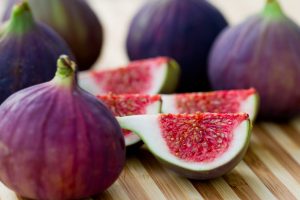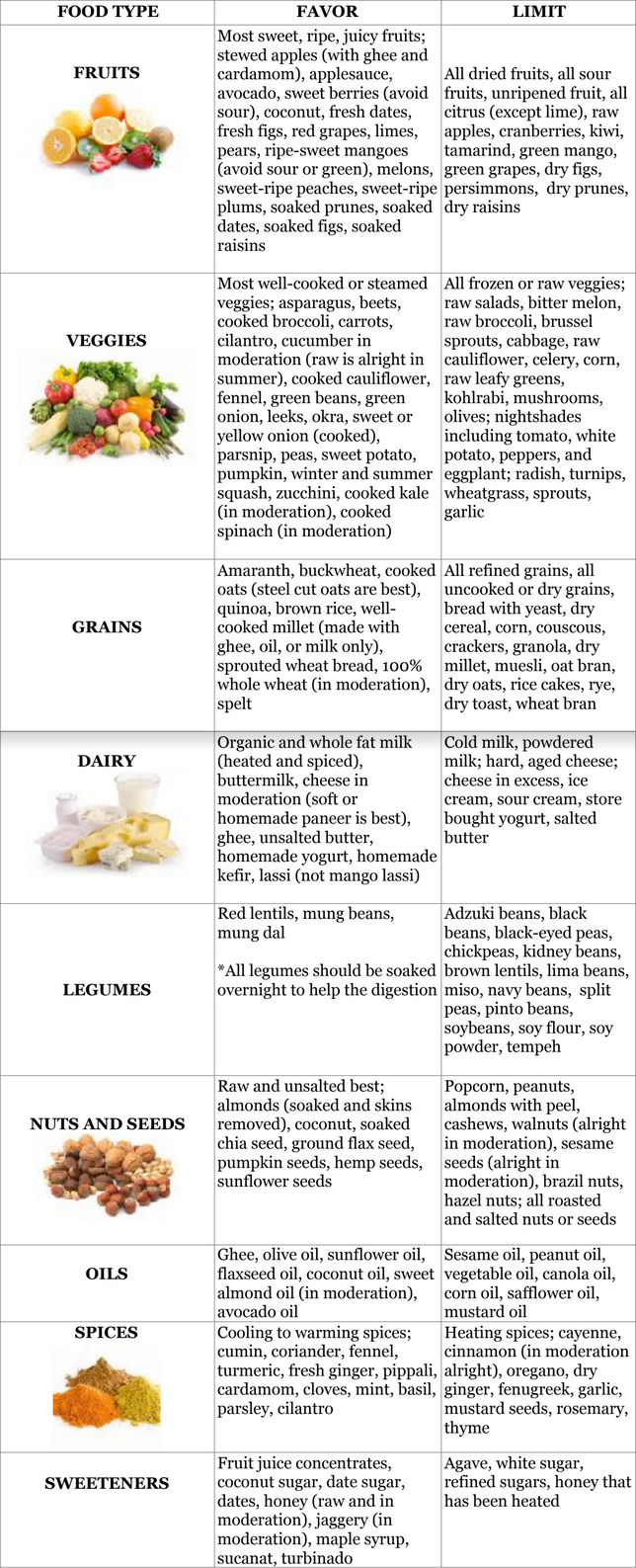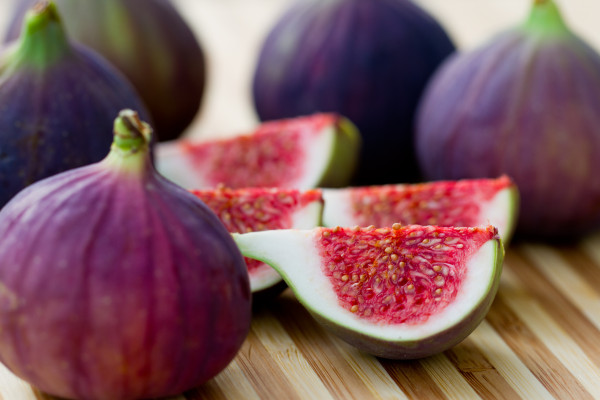 By knowing your specific Ayurvedic constitution (i.e. Vata, Pitta, Kapha) you can discover the best diet and lifestyle practices that will keep you healthy and in-balance. However, this is not always a black or white situation. In fact, there are countless grey areas that come up, making it much more difficult to decipher which recommendations to follow. If you have found that you reside with a predominance of both Vata and Pitta. . . or you are a Vata type with a Pitta imbalance. . . or a Pitta type with a Vata imbalance, keep reading to discover some of the foods and dietary guidelines that will help to bring balance to both “opposing” doshas.
By knowing your specific Ayurvedic constitution (i.e. Vata, Pitta, Kapha) you can discover the best diet and lifestyle practices that will keep you healthy and in-balance. However, this is not always a black or white situation. In fact, there are countless grey areas that come up, making it much more difficult to decipher which recommendations to follow. If you have found that you reside with a predominance of both Vata and Pitta. . . or you are a Vata type with a Pitta imbalance. . . or a Pitta type with a Vata imbalance, keep reading to discover some of the foods and dietary guidelines that will help to bring balance to both “opposing” doshas.
Take our Discover Your Dosha Quiz here!
When looking to bring balance to both Vata and Pitta, there are many foods that will work to pacify both doshas. Since Vata and Pitta are both light and mobile (pitta is actually “spreading”), many foods, drinks, and spices that are considered heavy and grounding will be healing for both dosha types. Pitta and Vata are calmed by the sweet taste, so welcoming healthy sweets in the diet will also be of benefit. Since Vata is cold by nature and Pitta hot, avoiding excessively cold or heating foods will be necessary while favoring more neutral or warming options instead.
Vata-Pitta Dietary Guidelines
Dietary Do’s
- In general, you will want to follow a stricter Pitta-reducing diet in the hotter months of the late spring, summer, and early fall and a stricter Vata-reducing diet in cool-cold months of fall and winter.
- Eat on a healthy meal schedule: 6-8am – nourishing breakfast upon awakening; 11am-1pm – hearty, healthy lunch; 6-7pm – small to medium-size dinner, light but fulfilling.
- Take a small, simple, healthy snack in between meals (e.g. piece of fruit; cup of plain yogurt with maple syrup; small wholegrain muffin) – read more on healthy snacking here!
- Favor sweet, juicy fruits such as ripe mango, ripe peaches, soaked raisins, dates, avocados, coconut, fresh figs, pears, ripe apricots, watermelon, and sweet plums.
- Favor well-cooked or steamed veggies such as beets (in fall or winter), carrots, okra, zucchini, yellow squash, winter squash (in fall or winter), sweet potatoes, asparagus, and sweet peas. Raw cucumber is alright in the summertime.
- Favor whole grains such as basmati rice, red rice, quinoa, buckwheat, whole wheat, spelt, and oats.
- Favor digestive spices that are not heating such as fresh ginger, turmeric, fennel, coriander, cilantro, parsley, cardamom, and cumin.
- Favor lime over lemon, avoid all other citrus.
- The best oils will be ghee, olive oil, sunflower oil, avocado oil, and coconut oil.
- Fermented foods should be limited to homemade kefir or yogurt.
- When all else fails, find tridoshic foods, spices, drinks, and recipes for fool-proof options!
Dietary Don’ts
- Avoid all raw and cold foods (may be acceptable in the summer season in small amounts).
- Avoid dry, rough, old, and stale foods.
- Avoid hot, spicy foods.
- Avoid heating spices such as cayenne pepper, dry ginger, and chili powder. Black pepper is alright in small amounts.
- Avoid highly acidic and inflammatory foods.
- Avoid nightshades such as tomatoes, white potatoes, peppers, and eggplant.
- Avoid fermented foods except homemade kefir or yogurt.
- Avoid refined sugar, refined grains, processed food, additives, dyes, caffeine, alcohol, and tobacco.
- Avoid improper food combinations (read more here).
- Avoid skipping meals or waiting too long to eat.
While adopting some of these beneficial dietary guidelines, you should also become familiar with the best foods to consume and which foods to limit or avoid. Please remember however, that these food charts are not all set in stone. If you love a food on the no-no list, you can likely enjoy it on occasion, especially if you are feeling in-balance. You can often “cheat” (with awareness and moderation) depending on the season and the context as well. For example, raw salad is said to be forbidden, however, if you are craving a cold, raw salad on a 90 degree summer day and you are not suffering from a severe Vata imbalance (insomnia, panic attacks, severe anxiety, sever gas and bloating, etc), then eating a salad dressed with olive oil, avocado, and lime juice would be totally acceptable. This same salad in the fall or wintertime, however, should definitely be avoided. Therefore, use this chart as a guide and learn where you are able to intelligently play around on occasion.
Click here for a printable version of this chart for your refrigerator!
Vata-Pitta Diet Chart

Click here for a printable version of this chart for your refrigerator!
Recipes To Balance Vata and Pitta
- Quick and Easy Ayurvedic Pancakes (with secret syrup!)
- Ojas-Increasing Oatmeal
- Simply Spiced Quinoa Porridge
- Rejuvenation Kitchari
- Vata-Reducing Kitchari
- Classic Cleansing Kitchari
- Deliciously Vibrant Chana and Mung Dal
- Savory Pumpkin Soup
- Roasted Butternut Squash and Coconut Soup
- Sweet Potato, Kale, and Brown Rice Scramble
- Saffron Spiced Golden Rice
- Coconut Cilantro Chutney
- Simply Steamed Veggie Recipe
- Healthy Wholegrain Chocolate Chip Cookies
- Cinnamon Spiced Sweet Potato Muffins
- The Essential Almond Milk
- Golden Milk
- Turmeric Milkshake (Dairy-Free!)
- Rejuvenating Ojas Drink
- Mind-Boosting Mesquite Power Drink
- Amazingly Addictive Homemade Hemp Milk
- Energizing Sweet Potato and Chia Seed Smoothie
- Homemade Kefir in 5 Easy Steps
- Quick and Easy Homemade Ghee



Does this also apply to Pitta-Vatta types?
Hi Louise,
This chart is for anyone whom is Vata and Pitta predominant (or Pitta and Vata predominant, same thing), or a Vata type with a Pitta imbalance, or a Pitta type with a Vata imbalance.
If you are a Pitta type and have secondary Vata in your constitution (written as: Vata 2, Pitta 3, Kapha 1), you should only follow this chart if your Vata is out of balance. If you are a Pitta type with secondary Vata, but you are not showing any symptoms of high Vata, you would likely want to stick to a Pitta-soothing diet and Pitta diet chart.
I hope this answers your question. Please let me know if you have any more questions and I will be happy to help as much as I can!
Namaste,
Danielle
Hi there 👋🏽
Which animal foods would be helpful for this dish a combination – especially to help with low iron levels? Is bone broth appropriate?
Thank you!
Cheers,
Alli
Hi Alli,
Thank you for your question.
Suitable iron-rich animal foods for Vata-Pitta types would be venison (very good source of iron!), white meat chicken or turkey, tuna, mussels, clams, and shrimp. Red meat (bison and beef) is the best source of iron but it is heating for Pitta and potentially hard to digest for Vata. Bone broth is great for Vata and Pitta (assuming it is not too oily), but most bone broths contain only small amounts of iron. It can be a great, easy to digest source of protein (especially collagen) and other nutrients however, so I would still recommend taking it regularly.
Since menstruating women needs at least 18 mg of iron daily (and about 36 mg for vegetarian women), it can be difficult to get this without consuming animal products with every meal. If needed, supplementing with a liquid, non-constipating iron supplement can be helpful for treating or preventing anemia. I have been using Floradix and Plant Force liquid iron supplements a few years with very happy results. I was severely anemic after my pregnancies with a total iron level of 12 (which should be 50 to 170 mcg/dL). I was able to raise this number to 90 in only three months after beginning these supplements. I still try to get plenty of iron-rich foods in my diet, but this allows me to eat a more plant-based diet (although I take bone broth daily and meat occasionally).
I hope this is not too much info, but since anemia is a real concern for many women, I thought I would share in hopes of helping you and any other women in need.
Let me know if any questions come up!
Namaste,
Danielle
Excellent 👌🏼 I’ll try your suggestions and see how it goes! Thanks for the great info!
Thank you for this amazing chart, tips, and answers to commenters’ questions. My dosha has historically been Pitta-Vata, but at 73 years old, I understand that a Vata diet and lifestyle regimen may be more suitable for my stage of life. If you agree, would you recommend following a Vata regimen throughout the year, disregarding seasonal variations?
Hi Margaret,
Thanks for your question! It is always important to eat with the season, even if you add Vata-pacifying to the regimen. No matter your constitution or your stage in life, your Pitta will be higher in summer, Vata in fall/winter, Kapha in winter/spring, etc, so this should be taken into consideration. When possible, it is always best to listen to the cues of your body/mind, as they will often let us know what we need at any given time.
So overall, it would likely be best to follow a Vata-soothing diet, but include any dosha that is in excess for the season or in excess in your own constitution.
I hope this helps to clarify (and doesn’t confuse you more).
Let me know if you have any further questions!
Many blessings,
Danielle